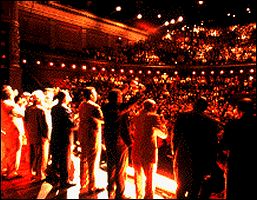![[Deep Focus]](../../flicker/logo.gif) |
|
|
BUENA VISTA SOCIAL CLUB | |
 |
GRADE: B+ | With the band |
|
In the opening scenes of the new documentary Buena Vista Social Club, 90-year-old guitarist Compay Segundo is walking the streets of Havana, quizzing elderly residents about the former location of the titular nightspot. Nobody seems to remember exactly where the club was built, although it was the center of a swirling and swinging Cuban jazz scene in the 1940s and 1950s. Indeed, Cuba seems to have suffered a bout of national amnesia where that musical tradition is concerned -- when American guitarist Ry Cooder showed up in Havana in 1996 to gather together a group of old-style musicians for a new recording of standards from that era, his work as a sort of cultural anthropologist was cut out for him. Unaware of whether these songsters were living or dead, Cooder identified some of the finest of those old songs, and then sought out their makers on the streets of Havana. The eventual result of Cooder's efforts was an album that bore his name but highlighted the musicianship of The Buena Vista Social Club, a largely forgotten group of Afro-Cuban performers who found, sometimes to their own surprise, that they still had what it takes to fill a recording studio -- or a concert hall -- with a distinctly joyous noise. In a rare example of cosmic justice finally being served, Cooder actually managed to bring these careers back to life before the performers were too ill or too dead to enjoy the revival. The resulting album, driven by intoxicating rhythms and a sly, relentless sensuality, sold a million copies worldwide, won a Grammy, and eventually put those players on stage together at historic concerts in Amsterdam and at Carnegie Hall. When Cooder returned to Havana last year to record a solo album by vocalist Ibraham Ferrer, filmmaker and longtime pal Wim Wenders went with him, and brought a camera crew. (Cooder scored Paris, Texas and The End of Violence for Wenders.) The result is an understated yet celebratory documentary that showcases these musicians as individuals, but celebrates their performance as a group. When we see a young fan dance down the aisles at the end of one performance, handing off a Cuban flag that the band holds aloft, it's clear that their pride is inclusive, rather than purely nationalist. Seldom could a better case be made for the ability of music to cross borders of politics and prejudice. The sensibility of Buena Vista Social Club is that of film itself seeking out the source of beauty in this world. In the most effective moments, Wenders' camera literally floats through rooms (much of the film was shot with a Steadicam) in slow, graceful arcs, taking in the architecture and moving inquisitively toward the source of music, a bit like a cat that has just smelled something delicious. Reproduced with the natural acoustics of this grand Spanish architecture, the sound is enveloping and inviting. When Wenders cuts freely to footage of the musicians on stage, the effect is magnificent. (Unfortunately, despite the presence of ace cinematographers Robbie Mueller and Lisa Rinzler behind the camera, Buena Vista Social Club is somewhat limited by its video source material, which leads to fuzzy edges and blasted-out exteriors on the big screen. This film should really sing in the home environment, especially with its outstanding six-channel sound mix cranked to an appropriate volume.) Wenders, an insistent sensualist and music buff, is well within his element here. The best things in his last good feature, Lisbon Story, were the impulses of a documentarian -- lovely cinematography, sensitive use of location, and the extensive footage of Portuguese band Madredeus -- that revealed the city itself, rather than his dialogue-heavy struggle with undergraduate ideas about the nature of cinema. The best film he will ever make, Wings of Desire, enjoyed a similarly strong sense of place, as ideas about the duality of the human spirit dovetailed with the geography of a city whose soul was split in two. Perhaps building on those ideas, Wenders illustrates the seeming duality between the conditions in economically depressed Cuba and the grace and charm of these musicians. But the film avoids overt social commentary, even glossing over the question of how difficult it must have been to secure permission for these artists to perform in the United States. The film's points are made more efficiently than that, never straying far from the music itself. The arthritic, outrageously talented keyboardist Rubén González, we're told, hasn't owned a piano in 10 years. Ferrer says he actually gave up singing and made his living shining shoes before Cooder came calling. Later, we watch Ferrer wander the streets of New York, his eyes agape as he wonders at the dubious marvels of a midtown Manhattan that he never guessed he'd visit. Even as he regrets the absence of his family, he says he's grateful that at least he can see these things and take those memories back home. The striking thing here is the capacity of the human soul for spontaneous beauty, even in the face of a fundamental disparity of fortunes. In fact, the inarguable life-affirming power of these performances can shame a viewer into reevaluating his own notion of good fortune and happiness. By the time Wenders tries to verbalize this theme -- a shot of Cuban graffito is inserted near the end of the film, subtitled "We believe in dreams" -- the point could hardly be more clear. | |
|
Directed by Wim Wenders Written by Mike Meyers and Michael McCullers Starring Ibrahim Ferrer, Compay Segundo, and Rubén González Germany/USA/France/Cuba, 1999 Theatrical aspect ratio: 1.85:1
| |

| |
 http://www.deep-focus.com/flicker/
bryant@deep-focus.com
http://www.deep-focus.com/flicker/
bryant@deep-focus.com